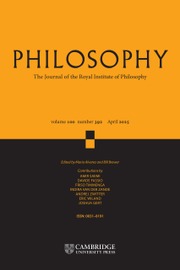No CrossRef data available.
Article contents
Wondering about the Impossible: On the Semantics of Counterpossibles by Maciej Sendłak, Synthese Library, Vol. 487, Springer International Publishing, 2024, 192pp., £99.99 (hbk) ISBN: 978-3-031-65360-5 doi: 10.1007/978-3-031-65361-2
Review products
Wondering about the Impossible: On the Semantics of Counterpossibles by Maciej Sendłak, Synthese Library, Vol. 487, Springer International Publishing, 2024, 192pp., £99.99 (hbk) ISBN: 978-3-031-65360-5 doi: 10.1007/978-3-031-65361-2
Published online by Cambridge University Press: 23 September 2025
Abstract
An abstract is not available for this content so a preview has been provided. Please use the Get access link above for information on how to access this content.

Information
- Type
- Review
- Information
- Copyright
- © The Author(s), 2025. Published by Cambridge University Press on behalf of The Royal Institute of Philosophy.
References
Chisholm, R. (1946). The Contrary-to-Fact Conditional. Mind, 55(220), 289–307.10.1093/mind/LV.219.289CrossRefGoogle Scholar
Chisholm, R. (1955). Law Statements and Counterfactual Inference. Analysis, 15(5), 97–105.10.1093/analys/15.5.97CrossRefGoogle Scholar
Douven, I., Elqayam, S., & Krzyżanowska, K. (2023). Inferentialism: A Manifesto. In Kaufmann, S., Over, D. E., & Sharma, G. (Eds.), Conditionals: Logic, Linguistics and Psychology (pp. 175–221). Springer International Publishing. https://doi.org/10.1007/978-3-031-05682-6_7CrossRefGoogle Scholar
Fine, K. (2012). Counterfactuals Without Possible Worlds. The Journal of Philosophy, 109(3), 221–246.10.5840/jphil201210938CrossRefGoogle Scholar
Fine, K. (2017). Truthmaker Semantics. In A Companion to the Philosophy of Language (pp. 556–577). John Wiley & Sons, Ltd. https://doi.org/10.1002/9781118972090.ch22CrossRefGoogle Scholar
Goodman, N. (1947). The Problem of Counterfactual Conditionals. The Journal of Philosophy, 44(5), 113–128.10.2307/2019988CrossRefGoogle Scholar
Laan, D. A. V. (1997). The Ontology of Impossible Worlds. Notre Dame Journal of Formal Logic, 38(4), 597–620. https://doi.org/10.1305/ndjfl/1039540772Google Scholar
Nolan, D. (2014). Hyperintensional Metaphysics. Philosophical Studies, 171(1), 149–160. https://doi.org/10.1007/s11098-013-0251-2CrossRefGoogle Scholar
Plantinga, A. (1976). Actualism and Possible Worlds. Theoria, 42, 139–160.10.1111/j.1755-2567.1976.tb00681.xCrossRefGoogle Scholar
Priest, G. (1997). Editor’s Introduction. Notre Dame Journal of Formal Logic, 38(4), 481–487. https://doi.org/10.1305/ndjfl/1039540765CrossRefGoogle Scholar
Priest, G. (2005). Towards Non-Being: The Logic and Metaphysics of Intentionality. Clarendon.10.1093/0199262543.001.0001CrossRefGoogle Scholar
Priest, G. (2016). Thinking the Impossible. Philosophical Studies, 173(10), 2649–2662. https://doi.org/10.1007/s11098-016-0668-5CrossRefGoogle Scholar
Ramsey, F. P. (1925). General Propositions and Causality. In Ramsey, F. P. (Ed.), The Foundations of Mathematics and Other Logical Essays (pp. 237–255). Routledge & Kegan Paul.Google Scholar
Stalnaker, R. (1968). A Theory of Conditionals. In Rescher, N. (Ed.), Studies in Logical Theory (pp. 98–112). Blackwell.Google Scholar


